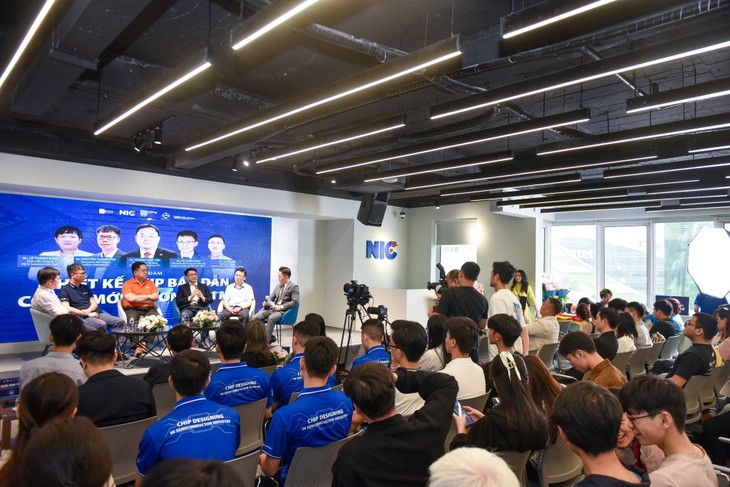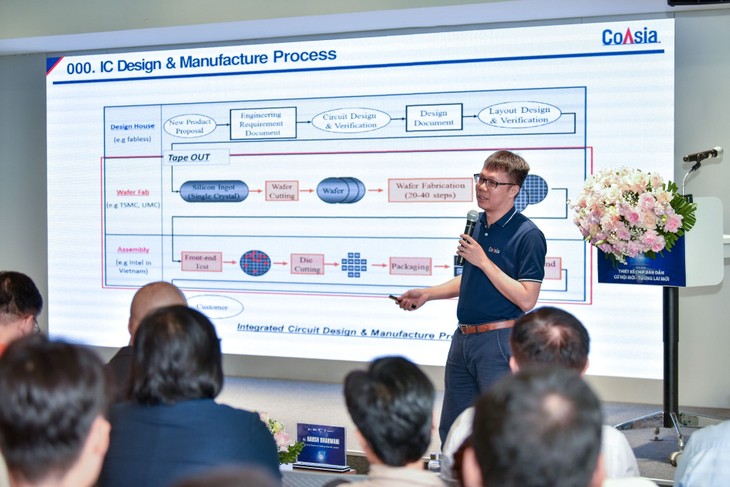(VOVWORLD) - Management consulting firm McKinsey & Company says job postings for technical semiconductor positions in the EU and US rose at a compound annual growth rate of more than 75% from 2018 to 2022. This is an “alarming” number, because it reflects a “red alert” situation around the world as the need for human resources in the semiconductor industry grows. This week Digital Life will look at the situation in Vietnam and suggest how Vietnamese youths can seize this opportunity. Designing semiconductor chips can earn new graduates a large salary.
 Speakers at the seminar on semiconductor chip design (Photo: NIC) Speakers at the seminar on semiconductor chip design (Photo: NIC) |
“I realize that last year the industry began to grow very strongly in Vietnam and, in the future, will follow the development of AI technology. The industry is stimulating students’ creativity. I see lots of job opportunities for young people who have an interest in chip design,” said Nguyen Ba Chien, a student at the University of Transport.
“First, it’s open to students now. Second, because what I'm studying at school now relates to chips. I decided to register for Jetking’s training course to gain more experience and expertise. The most attractive thing about this industry is its salaries and it’s at the forefront of the world technology,” said Le Ngoc Cuong, a student at the Hanoi University of Mining and Geology.
Chien and Cuong are among Vietnamese young people who are well aware of the boom of the semiconductor industry and the opportunities it’s bringing, including high salaries.
But what must chip design graduates do to earn the high salaries people are talking about?
 Harsh Bharwani, CEO of Jetking India (Photo: NIC) Harsh Bharwani, CEO of Jetking India (Photo: NIC) |
At a recent seminar in Hanoi on semiconductor chip design called “New opportunities - new future”, Harsh Bharwani, CEO of Jetking India, which has more than 75 years of experience in hardware and cybersecurity training, said the current global chip market is worth 500 billion USD and will soon grow to 1.8 trillion USD.
This is creating a huge demand for skilled workers, so personnel training in Vietnam has a great growth potential in the next 10 years.
There are a couple of advantages of Vietnam and why the Jetking has chosen to work in Vietnam, specifically in chip design and semiconductor, said Bharwani.
“One of the most important things is that in the past 12 years, we've found that Vietnamese students are extremely hardworking. They're very persistent and the way they learn is very diligently. They give very high respect to education. And that's one of the reasons I think the next 10 years is going to be really booming for Vietnamese students.”
But he also pointed out the areas which Vietnamese students should improve. They are a lack of knowledge of English and more theoretical and practical exposure.
“When it comes to learning technology, the more theory they understand the better, and then they need practical experience because the majority have too little practical experience. So, if they have an infrastructure where they can get practical experience, I think it would be really good for them,” said Bharwani.
 Nguyen Thanh Yen introduces the chip design and manufacturing process at the seminar. (Photo: NIC) Nguyen Thanh Yen introduces the chip design and manufacturing process at the seminar. (Photo: NIC)
|
Nguyen Thanh Yen, head of engineering at semiconductor manufacturer CoAsia Semi Vietnam and moderator of the Vietnam Microchip Community, a forum for semiconductor engineers, underscored the importance of continuously developing human resources for the semiconductor industry.
“When a foreign company sets up an office in Vietnam and build a local force of engineers, they will need those in the host nation. Engineers are a valuable asset of the company. They are the ones who are in charge of designing chips for the company’s customers or its own chips. These engineers are an anchor to keep foreign investment companies in Vietnam,” Yen noted.
In addition, according to Yen, the biggest challenge for young people who want to pursue chip design is big. They need passion and perseverance because it takes about 10 years to begin reaping the profits.
 Hoang Nam Tien, Vice Chairman of the FPT University Council (Photo: NIC) Hoang Nam Tien, Vice Chairman of the FPT University Council (Photo: NIC) |
Echoing Yen’s view, Hoang Nam Tien, Vice Chairman of the FPT University Council, underscored the importance of perseverance and self-discipline to achieve success in this field.
“I believe that one direction we should focus now is vocational training. It will likely take 15 to 20 months to get sufficient vocational training. Of course, after graduation, you still need more time to practice,” said Tien.
He added many people talk about experience. To gain experience, particularly good experience, costs time, money, and some pain. It’s the same in this industry. But now there’s another way to approach the issue – getting your training from gurus in the field. That will take you one year rather than the 3 to 5 years it used to take in the past.
One positive sign that suggests Vietnam’s semiconductor industry is about to take off is that many large semiconductor companies like Amkor Technology, Samsung, and Hanmi Semiconductor have built factories or expand production in Vietnam.
Vo Xuan Hoai, Deputy Director of the National Innovation Center (NIC), said, “"Vietnam is doing quite well, especially in regard to human resources for the semiconductor industry. We have set up comprehensive coordination between schools and human resource training facilities for the semiconductor industry. A spirit of solidarity is carrying us forward to achieve our common goal."
There has been a structural shift of the semiconductor value chain to Southeast Asian countries. As a result, Vietnam has the potential to turn a “red alert” into a “green light” for the development of its semiconductor industry, given its abundant engineering and technology workforce.